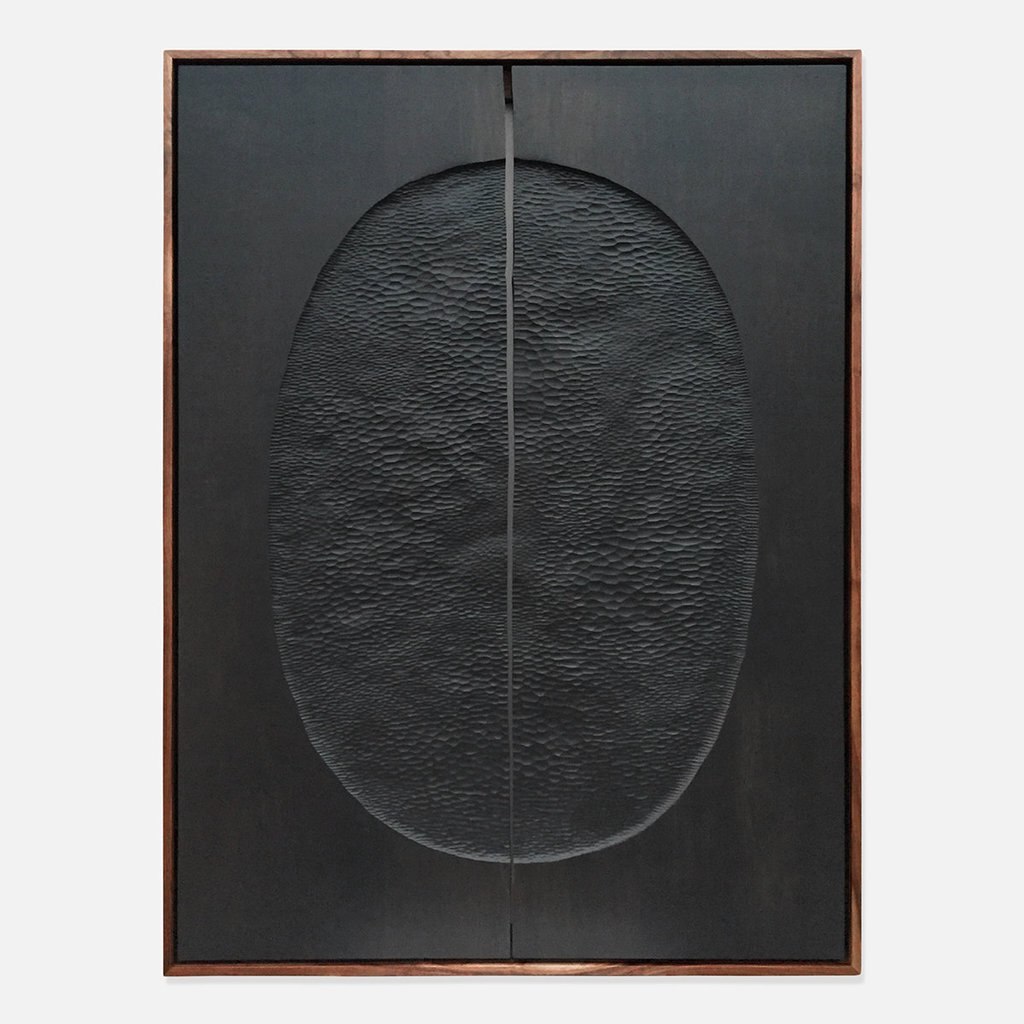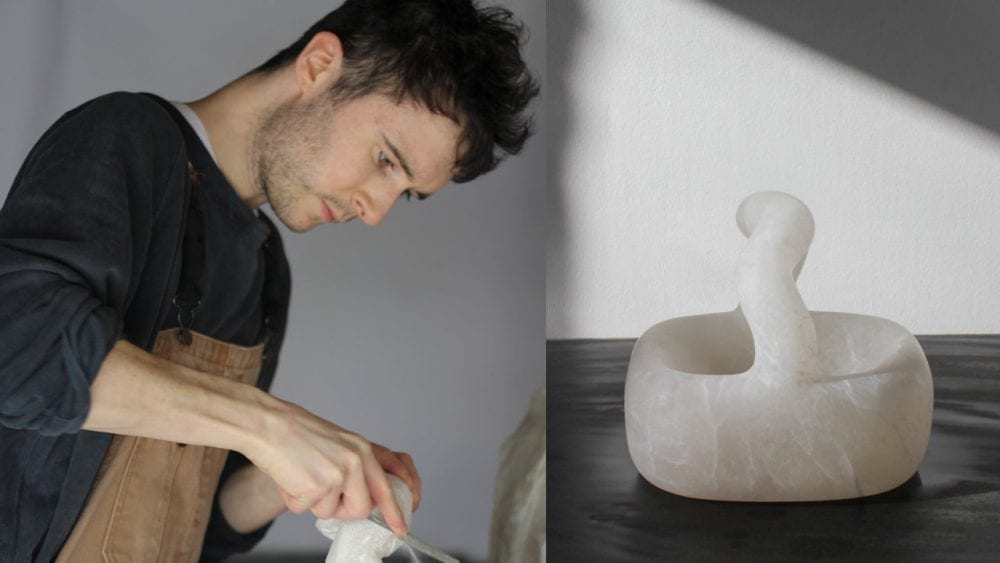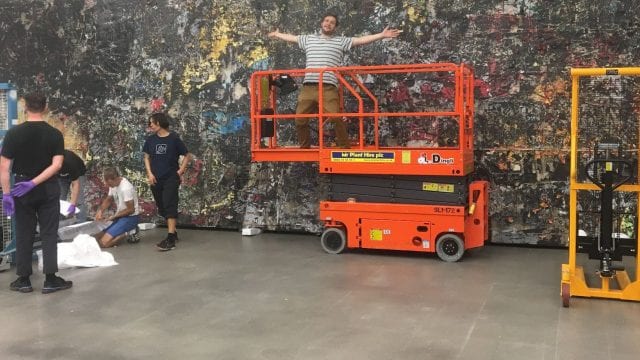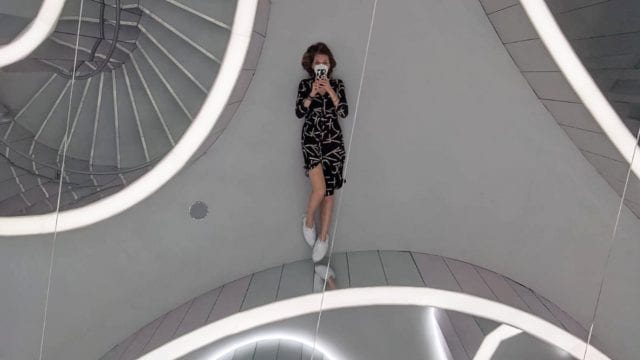Oliver Cook is a self-taught artist creating sculptural forms and functional objects in alabaster. Oliver has an upcoming exhibition at The Scottish Gallery in September. His works for sale can be viewed here.
What is your most memorable experience or achievement?
One of my most memorable experiences with art was taking part in the 1000 Vases exhibition in Paris last September. Walking up to the gallery and seeing my vase in the window, alongside all these amazing vases by many other artists, was such a good feeling. It was also the first time I’d been to Paris, so it was really nice to spend a few days there, walking around the city, visiting galleries and eating loads of amazing food.
Another memorable experience was going to New York with school and spending a week visiting The Guggenheim Museum, the Museum of Modern Art, and loads of other places. My school really valued taking students to see the artworks they were discussing in class, and they took us on many trips to the various galleries in London. Looking back, I’m very grateful to have had those experiences so early on. It’s certainly instilled an appreciation of seeing art in person.
If you could own any artwork, what would it be?
I came across a blog post about Hanna Eshel’s New York loft apartment. It was so beautiful, filled with light, and plants were occupying the space around her work. I admire all of her work and really hope to own a piece one day. If I could own any of hers, it would be some of the marble sculptures I saw in her loft; they were placed in the style of a Japanese stone garden and surrounded by raked sand. If it’s possible to have a collection of pieces, I would love to have them all, including the sand.
If I could only have one piece of artwork, it would be one of Julian Watt’s wall pieces — in particular, one of his carved paintings, dyed black using India ink. He’s another artist I look up to for his amazing work.

Do you feel like you’re drawn to sculptural works because of the work that you make?
Yes, definitely. I love paintings and drawings, but I think of my work as three dimensional. With sculptural works, there’s a lot more I can draw from as inspiration for my own work. If I had to choose, I think I would always choose a sculpture.
If there were a movie about your life, who would play you and what would it be called?
I would want Bill Murray to play me. He’s one of my favourite actors, and I love everything he’s in. I’m not too sure what the name would be though – that’s a difficult question.
I have a lot of projects and pieces that always seem to be 90% finished; so if a film is ever made about me, perhaps it could be based around that. I’d also want it to be directed by Wes Anderson.
What do you think is the best way to connect with or experience art?
The internet is such a vast resource and a great way for sharing work and following the work of other artists. However, visiting galleries will always be my favourite way to see art. It’s something I have really missed a lot over the past year.
When you see work in front of you, you see all the details that can’t be fully reproduced online: textures, markings, light and shadows. When I visit galleries, I always discover works that I probably would have never come across otherwise.
Back when I was living in Cambridge, I visited Kettle’s Yard. Whilst I was there, Jennifer Lee had a wonderful solo exhibition. I loved the simplicity and asymmetric curves of her vases. Her work definitely played a part in why I first started working with stone and began by carving a vase.
Part of the gallery is the house of Jim and Helen Ede. Their house has such an incredible collection of art, ceramics, sculptures, furniture, and all sorts of beautiful objects placed in a sort of harmony with each other. There is so much to see – you could go every day for a week and on the last day still find something new. It’s a great example of needing to visit a gallery in person to fully appreciate the gravitas of a collection of works or exhibition. Their house and also the loft of Hanna Eshel are perfect examples of showing works in context. Art looks great in galleries, placed on white plinths within vast minimal spaces, but I like to see what works look like in peoples’ homes, on a windowsill, or amongst the work of other artists.
Tell us a bit about your background, I believe you came to sculpting relatively recently?
I studied design at Loughborough, and since graduating, I’ve been working as a designer. Throughout, I’ve created things in my spare time: furniture, wood carving, and ceramics. Art and design have always been my favourite subjects, and I’ve consistently had a preference towards natural materials.
After coming across the work of Hanna Eshel and Isamu Noguchi in 2019, I really wanted to experiment with carving stone. Luckily, there was a stone yard nearby in Yelvertoft (now sadly closed), so I drove over to have a look. They stocked a wide variety of stone: marble (in many different colours), soapstone, limestone and alabaster. I was walking around looking at different boulders and sawn blocks, and I found it really difficult to make up my mind about what to buy.
I spoke to the owner, Michael Owen, for quite a long time. He told me about the different properties of each stone, the industry, and the history of his stone yard. It was fascinating. In the end, I bought two blocks: one white translucent and one rainbow. I had no intention of buying translucent alabaster, but I really liked how even in large, square-cut blocks, you could see the translucent properties.
Tell us about your working process.
I’ve been working with the translucent alabaster for some time now, and I’ve come to really appreciate how easy it is to work with. It’s just the right balance of hard and soft, which allows you to carve it quickly and polish it finely. I’ve also tried working with limestone, which I find much too soft and too easily marked. I’ve not had any formal training, so I’m still learning and developing my process and techniques. I’m finding out new ways of doing things all the time.
When I first start working on a piece, I’ll sketch out as many different design variations as I can think of. I’ll measure out the block of stone I’ll be using to plan each piece more accurately. Once I’m happy with the sketch and everything aligns properly, I’ll mark the cross-section views in pencil. Sometimes, after I’ve marked it out on the stone, I’ll alter the proportions slightly to account for any marks leftover from quarrying. When I begin shaping the stone, I use a saw to cut out the larger sections. This also helps to minimise the amount of dust produced. Then I’ll rough out the form using power tools – but I’m very cautious as it’s easy to take too much off if I remove the material too quickly. Once I’m happy with the rough form, I gradually refine the form with various rasps and chisels. This is a prolonged process.
Finally, when I’ve finished refining the form, I’ll start polishing the surface with sandpaper. Again, this quite a lengthy process, but the investment in time and effort is definitely worth it: the smoother the finish, the clearer the veining detail and the better the translucency.
I’ve started modelling the wavy handle parts of my bowls with thick aluminium wire, which really helps as a visual reference whilst I’m carving. I’ve also thought about using clay in the future to make smaller models of the entire piece, which I think will be especially valuable for asymmetric surface details.
I’m currently working on a collection for an upcoming exhibition with The Scottish Gallery in September. I’ve never had to create so many pieces at once, so I want to plan each piece and consider how they will look and interact with one another as a complete collection. I don’t want to create them one at a time, with no real plan.
Creating such a large body of work is proving to be a challenge, but it feels good to be doing something different and out of my comfort zone. It’s also provided me the opportunity to create some bigger pieces that further explore the way the stone interacts with its environment. I’m really excited to start sharing the work.
What happens if you make a mistake or decide you want to change a work? How forgiving is alabaster?
It’s very forgiving in many ways and not at all in others. Being a soft stone, it’s easy to remove material. If I start on a shape or a curve and later decide I want to go in another direction, it’s quite easy to smooth out the shape and form another curve. But the more material I remove and the closer I get to the final form, the margin for change gets smaller and smaller. When I first started carving, I would begin chiselling the stone without a clear idea of what I wanted to create. Now, I plan as much as possible before I even touch the stone.
Where do you work? I imagine it’s pretty messy.
I work in my home studio, but I also work in the garden sometimes because of the amount of dust produced when roughing out the shape. Sometimes when I’m using power tools in the studio, the amount of dust created means it’s hard to see my hands. Proper respiratory PPE is important.
How much is natural light important to your work? Does it guide the forms?
It’s always a consideration. The thickness of the material directly affects the amount of light that can pass through; this, in turn, lets you see more of the veining within the stone. With the wave vase, I have a combination of thick and thin as the waves undulate down the vase, so different sections appear lighter, creating an added depth.
The translucent property of the stone also means it reflects the environment in which it’s placed. If it’s in a window, the pastel morning light, or the warm colours during sunset, will be subtly refracted within the stone. This is why hollowing out the vases and bowls, always a slow and laborious process, is important to achieve the right degree of translucency within each piece.
I want to work more on pieces you can interact with and move from room to room; they can be placed in the parts of the house that get the best light over the year or incorporate some form of movement. The action of carrying is something that interests me a lot – there’s something so tactile and intuitive about picking up a bowl made of stone. That’s something I want to explore and incorporate more into my work: the interaction between the environment, the material and the person.





